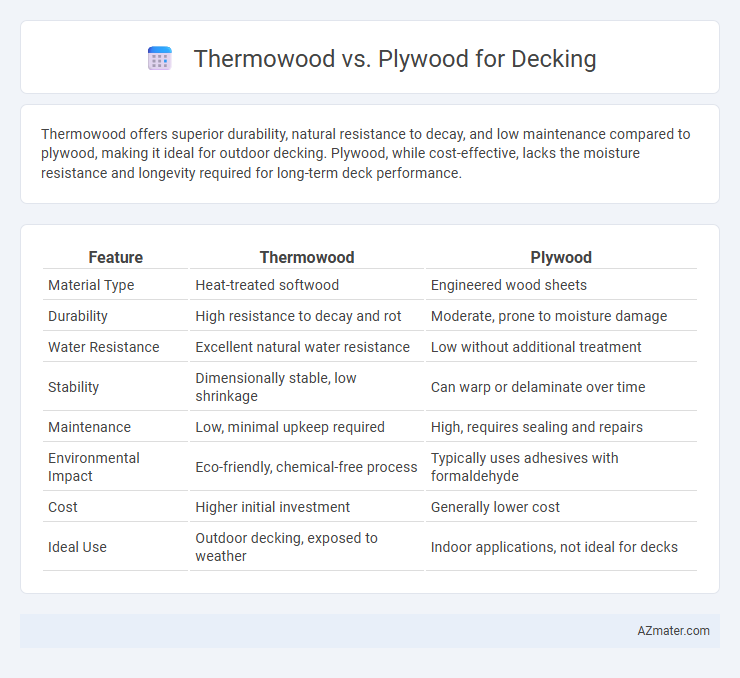Thermowood offers superior durability, natural resistance to decay, and low maintenance compared to plywood, making it ideal for outdoor decking. Plywood, while cost-effective, lacks the moisture resistance and longevity required for long-term deck performance.
Table of Comparison
| Feature | Thermowood | Plywood |
|---|---|---|
| Material Type | Heat-treated softwood | Engineered wood sheets |
| Durability | High resistance to decay and rot | Moderate, prone to moisture damage |
| Water Resistance | Excellent natural water resistance | Low without additional treatment |
| Stability | Dimensionally stable, low shrinkage | Can warp or delaminate over time |
| Maintenance | Low, minimal upkeep required | High, requires sealing and repairs |
| Environmental Impact | Eco-friendly, chemical-free process | Typically uses adhesives with formaldehyde |
| Cost | Higher initial investment | Generally lower cost |
| Ideal Use | Outdoor decking, exposed to weather | Indoor applications, not ideal for decks |
Introduction to Decking Materials
Thermowood and plywood are popular decking materials known for their durability and aesthetic appeal. Thermowood undergoes heat treatment enhancing its resistance to moisture, insects, and decay, making it ideal for outdoor use. Plywood offers structural strength and cost-effectiveness but requires protective finishes to withstand weather conditions in decking applications.
What is Thermowood?
Thermowood is a type of heat-treated timber that undergoes a thermal modification process to enhance its durability, stability, and resistance to decay, making it ideal for outdoor decking applications. Unlike plywood, which is manufactured by bonding layers of wood veneers, Thermowood is a solid piece of wood that retains its natural grain and strength. The thermal treatment reduces moisture absorption and increases resistance to fungal attacks, providing a sustainable and low-maintenance alternative for decking materials.
What is Plywood?
Plywood is an engineered wood product made by gluing together thin layers of wood veneers with grains alternating at right angles, enhancing strength and stability for outdoor decking applications. Its durability and resistance to warping depend on the adhesives used and the type of wood veneers, often requiring treatments for moisture resistance. Compared to Thermowood, which is thermally modified pine or spruce offering natural durability and dimensional stability, plywood can be more affordable but may need additional protective coatings for long-term performance on decks.
Thermowood: Key Features and Benefits
Thermowood offers exceptional durability and resistance to decay, making it ideal for outdoor decking applications where longevity is crucial. Its eco-friendly thermal modification process enhances dimensional stability and reduces moisture absorption without the need for chemicals. This results in a low-maintenance, sustainable decking material that outperforms conventional plywood in weather resistance and strength.
Plywood: Key Features and Benefits
Plywood used in decking offers exceptional strength and durability due to its multi-layered construction, making it resistant to warping and splitting. It is typically treated to withstand moisture, insects, and decay, ensuring a long-lasting deck surface even in challenging outdoor environments. The versatility and cost-effectiveness of plywood make it a popular choice for decking projects requiring both structural support and a smooth finish.
Durability and Lifespan Comparison
Thermowood decking offers superior durability due to its enhanced resistance to decay, moisture, and insect damage compared to traditional plywood, which is more prone to warping and delamination when exposed to outdoor elements. The thermal modification process increases wood stability and lifespan, often extending Thermowood decking's service life to 25-30 years, whereas plywood typically lasts around 10-15 years in outdoor conditions. Choosing Thermowood can significantly reduce maintenance costs and frequency, making it a more sustainable option for long-term decking applications.
Weather Resistance: Thermowood vs Plywood
Thermowood offers superior weather resistance compared to plywood due to its thermal modification process, which enhances its durability against moisture, decay, and insect attacks. Plywood tends to absorb water more easily, leading to swelling, delamination, and reduced lifespan when exposed to outdoor elements. Thermowood's stable cell structure and low moisture content make it a more reliable choice for decking in harsh weather conditions.
Maintenance Requirements
Thermowood decking requires minimal maintenance due to its heat-treated wood fibers, which increase resistance to rot, decay, and insect attacks. Plywood decking demands regular sealing and waterproof treatments to prevent delamination, warping, and moisture damage, especially in outdoor settings. Choosing Thermowood reduces the frequency of refinishing, making it a more durable option for low-maintenance decking solutions.
Cost Analysis and Investment Value
Thermowood offers a higher initial cost compared to plywood, but its enhanced durability and resistance to moisture and decay result in lower maintenance expenses over time. Plywood is more affordable upfront but may incur increased replacement and repair costs due to its susceptibility to weather damage and delamination. Investing in Thermowood provides better long-term value through extended lifespan and improved structural integrity in decking applications.
Best Applications: Choosing the Right Material
Thermowood offers superior durability and resistance to decay, making it ideal for outdoor decking exposed to harsh weather conditions and moisture. Plywood, while more affordable and versatile, suits covered or low-exposure decking areas where water resistance is less critical. For long-lasting, low-maintenance decks, Thermowood is preferred, whereas plywood fits budget-conscious projects requiring structural support under protective finishes.

Infographic: Thermowood vs Plywood for Decking
 azmater.com
azmater.com